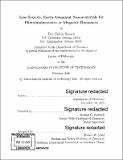| dc.contributor.advisor | Moungi G. Bawendi. | en_US |
| dc.contributor.author | Hansen, Eric Calvin. | en_US |
| dc.contributor.other | Massachusetts Institute of Technology. Department of Chemistry. | en_US |
| dc.date.accessioned | 2020-10-18T21:35:06Z | |
| dc.date.available | 2020-10-18T21:35:06Z | |
| dc.date.copyright | 2020 | en_US |
| dc.date.issued | 2020 | en_US |
| dc.identifier.uri | https://hdl.handle.net/1721.1/128068 | |
| dc.description | Thesis: Ph. D., Massachusetts Institute of Technology, Department of Chemistry, 2020 | en_US |
| dc.description | Cataloged from the PDF of thesis. | en_US |
| dc.description | Includes bibliographical references (pages 111-119). | en_US |
| dc.description.abstract | Many recently-developed molecular, nanoscale, or macroscale materials intended for energy and medical science application are composed of toxic and/or rare elements, and are therefore unlikely to be commercially translated. In response, this thesis will explore the design, synthesis, characterization, and application of Magnetic Resonance Imaging (MRI) contrast agents (CAs) and photoluminescent nanocrystals (NCs) based on Earth-abundant, non-toxic elements. For instance, many colloidal semiconductor NCs show bright, tunable photoluminescence (PL) useful for displays and photovoltaics, but often contain highly-toxic Cadmium (Cd) and/or Lead (Pb). Analogously, clinically-available Gadolinium based (Gd-based) MRI CAs have been found to accumulate in the brain and other organs, even for healthy patients.[1, 2, 3] Although the toxicity of retained Gd-based CAs is not fully understood, a solution containing an endogenous metal (such as Iron³⁺ (Fe³⁺)) is a safer option. This thesis is divided into two themes: MRI CAs and photoluminescent NCs. First, we will explore a nanoparticle-based (NP-based) MRI CA and its in vivo efficacy. Next, small molecule Iron-containing complexes based on Iron chelation therapy drugs will be described. Changing direction, chemical study and optimization of Indium-based (In-based) ternary NCs will be presented. Finally, synthesis of Aluminum-containing (Al-containing) defective NCs (DNCs) and respective photophysical processes will be reported. The results presented here provide a starting point for realization of translatable nanomaterials for light downconversion or MRI contrast. | en_US |
| dc.description.statementofresponsibility | by Eric Calvin Hansen. | en_US |
| dc.format.extent | 119 pages | en_US |
| dc.language.iso | eng | en_US |
| dc.publisher | Massachusetts Institute of Technology | en_US |
| dc.rights | MIT theses may be protected by copyright. Please reuse MIT thesis content according to the MIT Libraries Permissions Policy, which is available through the URL provided. | en_US |
| dc.rights.uri | http://dspace.mit.edu/handle/1721.1/7582 | en_US |
| dc.subject | Chemistry. | en_US |
| dc.title | Low-toxicity, earth-abundant nanomaterials for photoluminescence or magnetic resonance | en_US |
| dc.type | Thesis | en_US |
| dc.description.degree | Ph. D. | en_US |
| dc.contributor.department | Massachusetts Institute of Technology. Department of Chemistry | en_US |
| dc.identifier.oclc | 1199083177 | en_US |
| dc.description.collection | Ph.D. Massachusetts Institute of Technology, Department of Chemistry | en_US |
| dspace.imported | 2020-10-18T21:35:00Z | en_US |
| mit.thesis.degree | Doctoral | en_US |
| mit.thesis.department | Chem | en_US |
